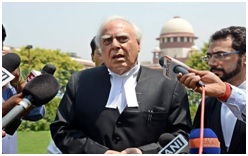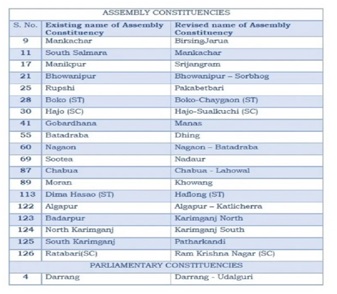In a move with far-reaching implications for Assam and potentially for India, the Election Commission of India (ECI) has unveiled the final order for the delimitation of Parliamentary and Assembly Constituencies in Assam. The ECI’s draft, procedural response to critiques and the final order has once has once again ignited discussions, and serious concerns on both constitutional validity of the Act and the representation of marginalised and minority communities. Five constituencies which always elect legislators from the minority community have also been reserved for either Scheduled Caste (SC) or Scheduled Tribe (ST) contestants, the Times of India reported. The All India United Democratic Front (AIUDF) party, whose primary voter base is among Assam’s Bengali-origin Muslims, has said that the delimitation exercise will reduce the number of Muslim-majority assembly constituencies in the state from 29 to 22.
The news of the ECI’s move also comes at a turbulent period when the parliament introduced a bill in the Rajya Sabha on Wednesday last week that will allow the PM to select a minister to replace the Chief Justice of India in the committee which will select the Election Commission members, including the Chief Election Commissioner. Raising serious questions of the union government’s intent—in this case to remote control the entire election process —it also will overturn an earlier judgement of the Supreme Court. Arguably then, if this control of the ECI itself is left unchallenged even by the Supreme Court the nationwide de-limitation process due in 2026 will itself be controlled by any government in power at the time.
The final de-limitation order, released under Section 8-A of the Representation of the People Act, 1950, marks a crucial development on Assam’s electoral map. The commission’s press release, released on August 11, detailed that its approach involved an extensive consultative process with a wide range of stakeholders. This included three days of public hearings in Guwahati in July 2023, supplemented by pre-meetings held in March 2023. According the press note, all representations, suggestions, and objections were considered by the commission, composed of Chief Election Commissioner Rajiv Kumar and Election Commissioners Anup Chandra Pandey and Arun Goel.
As many as 30 assembly constituencies will cease to exist in their current form while 26 new ones will be created, the Economic Times had reported in June. The final order did not further change any constituency boundaries, but renamed 19 assembly constituencies and one parliamentary constituency.
Representatives from various opposition national and state parties, including Aam Aadmi Party, Indian National Congress, Communist Party of India (Marxist), and Bharatiya Janata Party, as well as state-specific parties like All India United Democratic Front (AIUDF), Asom Gana Parishad, United Peoples Party Liberal, and Bodoland People’s Front, provided their feedback and suggestions to the Commission. Additionally, the United Opposition Forum Assam, comprising of multiple parties, and Registered Unrecognized Political Parties (RUPPs) such as Raijor Dal, Bhartiya Gana Parishad, National Republican Congress, and Assam Jatiya Parishad, also took part in the discussions. Over the course of three days, the Commission engaged with more than 1200 representations from 31 districts and conducted meetings with over 20 political parties.
The commission says it incorporated. Around 45% of the total 1222 suggestions/objections. According to the press release, while some 5 % of the demands were found to be outside the bounds of constitutional and statutory provisions, and the rest of the 50 % were not deemed suitable. According to a report by The Hindu, the poll panel has largely retained the changes that were introduced in the original draft proposal released earlier in the year.
The current chief minister of Assam, Himanta Biswa Sarma –whose term has been marred by aggressive steps and posturing against the state’s minorities– has also given his support to the ECI earlier. Assam chief minister and BJP leader Himanta Biswa Sarma had earlier said that if the ECI’s draft proposal was approved, the “people of Assam” would have a greater say in their constituencies.
“Assam should not be taken over by unfamiliar persons, and for that we worked religiously to protect jati [community], mati [land], and bheti [foundation], so as to retain the political power in the hands of our people.”
আমাৰ লক্ষ্য – জাতি, মাটি আৰু ভেটিৰ সুৰক্ষা
We are committed to protect the interests of our indigenous communities.
If the EC’s draft on delimitation is approved, people of Assam will have a greater say in their constituencies.
📍Lakhimpur#MahaJansamparkAbhiyan pic.twitter.com/sQ6ZWatM2L
— Himanta Biswa Sarma (@himantabiswa) June 23, 2023
His remarks and the delimitation proposal have been criticised as an attempt to weaken the representation of the state’s Bengali-origin Muslim community, who are often vilified as illegal immigrants from neighbouring Muslim-majority Bangladesh.
It is also not a coincidence that it is only the current ruling party BJP remains to be one party that welcomes the order, amidst many oppositions by other parties, including the Congress and AIUDF.
Gaurav Gogoi, a two term MP from the Congress party in Assam, has stated on Twitter that the Delimitation Exercise only ‘suits’ the BJP.
Election Commission publishes delimitation of Assam in 2023 based on 22 year old census. Hence no benefit to Assam in terms of increase in Lok Sabha seats. The result is a reorganization of existing seats to suit BJP voting trends. No wonder BJP doesn’t want CJI to select ECs.
— Gaurav Gogoi (@GauravGogoiAsm) August 11, 2023
Changes in the Final Draft
The delimitation exercise is based on the 2001 Census data a move which has been largely questioned by critics. The last delimitation was carried out in Assam in 2008. The latest delimitation exercise has resulted in the allocation of 126 Assembly Constituencies (ACs) and 14 Parliamentary Constituencies (PCs) in Assam. The commission’s final proposal includes revisions to the names of certain constituencies. Existing names such as Mankachar and South Salmara have been changed to Birsing Jarua and Mankachar respectively, amongst other changes.
Image: ECI Final Order.
When the initial draft was released, many apprehensions were made as for the new allocation of constituencies reserved for the scheduled castes (SCs). According to the final order, the SC seats are distributed among districts based on the proportion of the population of SCs in each district compared to the overall SC population in the entire state. Within each district, the priority was given to assembly seats with the highest proportion of SC population in relation to the total population of that assembly constituency. Similarly, for Parliamentary Constituencies, the one with the highest proportional SC population in relation to the total population of that parliamentary constituency was reserved for SCs. In 2001, the Scheduled Caste (SC) population stood at 1,825,949 out of the total population of 26,655,528. This proportion of SCs in the population was calculated to be 0.0685. The state had a total of 126 Assembly Constituencies (ACs), out of which 9 were to be reserved for SCs. Additionally, there were 14 Parliamentary Constituencies (PCs), with 1 PC earmarked for reservation for SCs. The ECI has argued that these changes in reservation for SC and ST communities were made according to Articles 330 and 332 of the Constitution.
According to Barak Bulletin, Silchar MP Rajdeep Roy had warned that there would be ‘Kashmirisation’ of Silchar if it becomes an unreserved constituency. Similarly, according to report, the main request of Barak Valley’s residents was to restore the Assembly representation to 15 seats. However, the Election Commission of India’s final draft stipulated 13 seats for the region. Notably, Algapur and Katlicherra, previously separate constituencies, were combined into Algapur-Katlicherra. Similarly, Badarpur merged with North Karimganj, now known as North Karimganj. Acknowledging Minister Parimal Suklabaidya’s objection, the ECI retained the name of Dholai Constituency, despite the initial proposal to rename it.
A significant development is the reduction in the size of the Silchar Legislative Assembly, both in geographic and electoral terms. Wards 1 to 7 of the current Silchar Municipal Board have been excluded from Silchar LAC. Furthermore, the ECI’s final draft confirmed that the Silchar Parliamentary Constituency, one of Barak Valley’s two constituencies along with Hailakandi-Karimganj, will continue to be reserved for SC candidates. It is notable that the Hailakandi-Karimganj constituency, formerly reserved for SC candidates, is now open to general candidates.
Opposition protests against the order
In the Supreme Court of India, writ petitions were submitted by Rajya Sabha member Ajit Kumar Bhuyan and Dr. Hiren Gohain, as well as one by the opposition parties. These petitions highlighted that the earlier postponement of the delimitation exercise was due to its reliance on outdated 2001 Census data. Given that India’s most recent Census was in 2011, it would naturally contains more current and updated data compared to the information from 2001, but there are no reports of the 2011 data included.
On July 24, the Supreme Court declined to put a stay on the delimitation process in Assam. The Court directed the Union government and the poll panel to provide their responses to a set of pleas on this matter. A bench led by Chief Justice D Y Chandrachud, alongside Justices J B Pardiwala and Manoj Misra however decided that they will look into the constitutionality of Section 8A of the Representation of the People Act, 1950. This is the section which grants the Election Commission the power to carry out constituency delimitation.

During the hearing for the petition, representing the petitioners, senior advocate Kapil Sibal, representing the opposition party leaders, argued against the commission stating that traditionally, this task was handled by a Delimitation Commission consisting of a retired Supreme Court judge and people’s representatives. He contended that entrusting the process to the ECI lacked a rational basis.
The proposed changes have triggered responses on the ground as well. Organisations and political parties had earlier called for a 12-hour strike in certain districts of Barak Valley in June, at the release of the ECI’s delimitation draft.
According to an earlier report by Sabrang India, a contentious aspect of the proposal centres on the potential elimination of assembly seats with Muslim-majority populations. This move has invited criticism from opposition parties, who assert that these constituencies often represent the Bengali-origin Muslim community, leading to concerns of minority representation and potential bias.
According to the report, the draft’s provisions suggest merging or incorporating such seats into newly-formed constituencies, some of which house significant Hindu populations.
India’s next nationwide delimitation is slated for 2026, while Assam’s last comprehensive delimitation was performed in 2008, with a subsequent deferral. This raises the question as to what was the hurry to perform a delimitation exercise specifically for Assam just a few years away from the all India exercise? The fact that the Lok Sabha elections are just a year further raises significant questions.
Related
Assam: Delimitation of Assembly, Parliamentary Seats, Merging of Districts Raise Apprehensions
Protests erupt over ECI’s new delimitation draft in Assam which is embroiled in controversy
Election Commission of India says voters’ names not to be removed without prior notice


